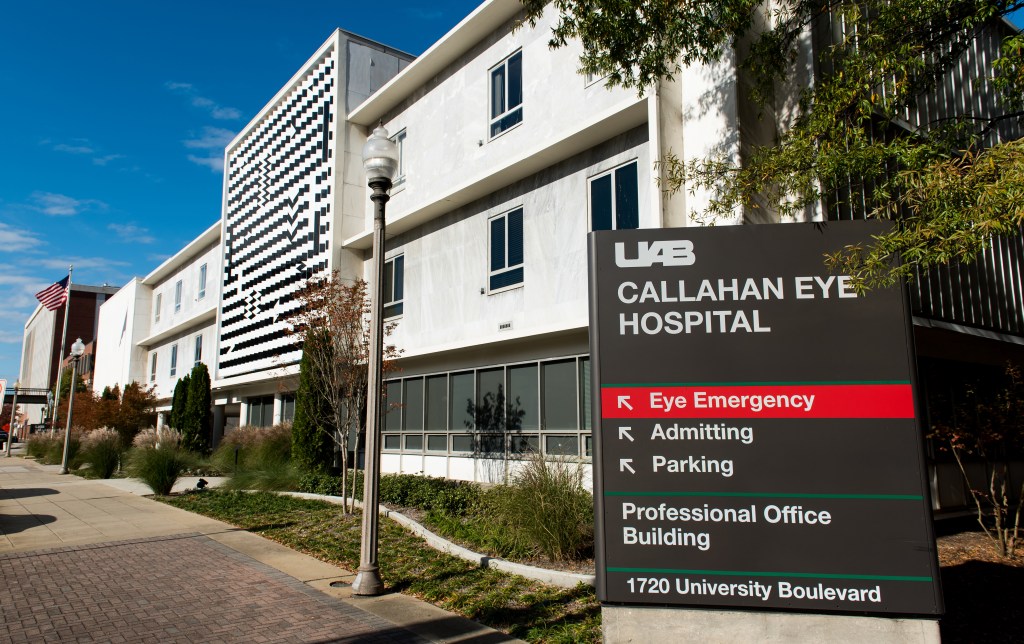
UAB Hospital-Callahan Eye Emergency Department
Birmingham, AL 35233
Located on the first floor of the UAB Hospital-Callahan Eye, the UAB Hospital-Callahan Eye Emergency Department serves as a comprehensive, fully dedicated Eye Emergency / Trauma Department. UAB Hospital-Callahan Eye Emergency Department provides the only 24/7 emergency department totally dedicated to eye emergencies and eye trauma in Alabama and one of only two in the nation.
We serve as a local and regional referral center for management of eye emergencies and eye trauma and our reputation in ocular trauma has led to both national and international referrals. The department is open 24 hours per day, 7 days per week.
As the region’s only freestanding 24/7 dedicated eye emergency department, we provide 24/7 access to:
- Ophthalmology specialty trained physicians and nurses
- All ophthalmology sub-specialties as needed
- Emergency eye surgery
- Specialty equipped emergency department and operating rooms
- All necessary diagnostic testing
- Other medical specialties as needed
- Ophthalmology telephone consultation with other health care providers on appropriate initial management and the most appropriate access to resources to meet the needs of the patient
Phone: 205.325.8100
Eye ER: 205.325.8254
Many eye injuries happen without our awareness of how they happened or when with symptoms occurring after the initial injury. They may occur from everyday activities such as prolonged wear of contact lenses, a scratch from makeup brushes, splashes of chemicals (example: cleaning solutions), tree/shrub branches scratch eye during hikes or lawn maintenance.
The eye may become scratched from a fingernail or a pet’s nail. Other times injuries occur during an explosion, assault, or motor vehicle accident. Eye injuries occur in many locations such as in the home, workplace, automobile accidents, and during participation in sports activities.
Eye emergencies may result from elevated pressure in the eye such as in glaucoma or as a complication following eye surgery.
How do I recognize an eye emergency / injury?
- Pain in the eye or orbital area
- Sudden decreasing vision
- Drainage from the eye
- Headache
- Swelling
- Redness of the eye or orbital area
Frequent causes of eye injuries:
- Sports injuries – impact of ball to eye, impact from knees, elbows, impact to head or eye/orbit area, debris from ground flying into the eye
- Workplace injuries – metal shavings, welding, nail guns, chemical splash/exposure to eye
- Home- chemical splash/exposure to eye, power tools (saws, nail guns), lawn maintenance (cutting grass or weed eaters throwing debris such as sticks or rocks)
- Fireworks – personal use or bystander
- Motor vehicle accidents
- Assault – blow to the eye, gunshot to eye, stab wound to eye
Injuries may be the result of blunt force to the eye / orbital area, foreign body to the eye, or a penetrating injury to the eye. Injury may include a combination of these.
Eye emergencies / injuries can’t be diagnosed over the telephone. If you are concerned about your eye, please come to our eye emergency / trauma department.
Our eye emergency/trauma department has ophthalmology specialty trained physicians and nursing staff available 24/7; as well as access to all the special supplies, instrumentation, and equipment needed to properly evaluate eye emergencies / injuries.
UAB Hospital-Callahan Eye reports eye injury data to the United States Eye Injury Registry in order to help us identify causes of injury and develop prevention strategies. We will work with industry/businesses to identify causes in the workplace and help develop strategies to reduce workplace injuries. We will also work with youth sports programs on injury prevention and initial management of eye injuries.
The best injury prevention measure you can take is the use of appropriate eye safety glasses or goggles
Public education also plays an important role because awareness of how injuries occur leads to exercising more care during certain activities
Fireworks and Eye Injuries:
Each Fourth of July, thousands of people are injured from using consumer fireworks. According to the U.S. Consumer Product Safety Commission, more than 9,000 fireworks-related injuries happen each year. Of these, nearly half are head-related injuries with nearly 30 percent of these injuries to the eyes. One-fourth of fireworks eye injuries result in permanent vision loss or blindness.
July is Fireworks Eye Safety Awareness Month, and the UAB Hospital-Callahan Eye Emergency Department wants to remind consumers to leave fireworks to professionals. “Too many Fourth of July celebrations are ruined because a child has to be rushed to the emergency room after a fireworks accident. Potentially blinding injuries can be avoided if families attend a professional public fireworks display instead of putting on a home fireworks display.
Children are the most common victims of firework accidents, with those fifteen years old or younger accounting for half of all fireworks eye injuries in the United States. For children under the age of five, seemingly innocent sparklers account for one-third of all fireworks injuries. Sparklers can burn at nearly 2,000 degrees Fahrenheit, which is hot enough to cause a third-degree burn.
“Among the most serious injuries are abrupt trauma to the eye from bottle rockets. The rockets fly erratically, often injuring bystanders. Injuries from bottle rockets can include eye lid lacerations, corneal abrasions, traumatic cataract, retinal detachment, optic nerve damage, rupture of the eyeball, eye muscle damage, and complete blindness.
Recommendations to prevent eye injuries include:
- Never let children play with fireworks of any type.
- View fireworks from a safe distance: at least 500 feet away, or up to a quarter of a mile for best viewing.
- Respect safety barriers set up to allow pyrotechnicians to do their jobs safely.
- Leave the lighting of fireworks to trained professionals.
- Follow directives given by event ushers or public safety personnel.
- If you find unexploded fireworks remains, do not touch them. Immediately contact your local fire or police departments.
- If you get an eye injury from fireworks, seek medical help immediately.
